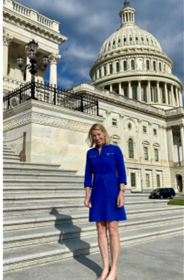How I Advocated for the Porphyria Patient Community on Capitol Hill
A columnist shares the policy changes she requested to improve patient care
Written by |

Last week, on Sept. 18–20, the American Academy of Dermatology Association held its annual legislative conference in Washington, D.C., where several hundred dermatologists and patient advocates gathered to discuss healthcare policy issues and advocacy.
Then, on Sept. 20–22, the Coalition of Skin Diseases (CSD) held its Hill Day, an equally impressive conference where nonprofit groups represented the 84 million Americans living with skin diseases.
As the mom and caregiver of a child with erythropoietic protoporphyria (EPP) and the president of the United Porphyrias Association, one of CSD’s associate groups, I was honored to join others this week on Capitol Hill to advocate for and talk about the needs of our porphyria patient community.
The porphyrias are a group of diseases caused by disruptions in the production of heme, a molecule that helps red blood cells carry oxygen throughout the body. For those with cutaneous porphyria, many symptoms manifest through the skin. Because of this, dermatologists frequently diagnose and manage porphyria patients. Additionally, Scenesse (afamelanotide), the only drug that’s been approved by the U.S. Food and Drug Administration specifically for EPP treatment, is most often prescribed by dermatologists.
Washington is a stone’s throw from my home in Bethesda, Maryland, but it feels like another world. Advocating on Capitol Hill is a unique experience that’s equally exhilarating and exhausting. Afterward, I arrive home with a fresh view of how Congress manages legislative issues. My sore feet and blisters serve as a reminder of the conversations.

Kristen advocates for porphyria patients on Capitol Hill in September. (Courtesy of Kristen Wheeden)
The impressive U.S. Capitol building is the centerpiece of the Hill, with the House of Representatives and Senate offices flanking it on either side. Meetings are scheduled and formal, often requiring speed walking to get from one to the next on time. Most are with healthcare-focused staffers who bring the issues to their elected bosses.
The COVID-19 pandemic restricted typical Hill meetings until recently. As a result of this, along with the upcoming midterm elections, Congress was bustling. Hill staffers met advocates at each entry point and guided us to our scheduled meetings.
Fueled by the myriad challenges we face, we navigated the legislative offices to share our concerns and request changes that we believe will improve patient care, such as increasing funding to research institutions and enacting policies that we believe would benefit both patients and physicians.
It’s appropriations season — the time each year when Congress reviews and approves the federal government’s budget for the upcoming fiscal year. Our team of advocates sought to secure and increase funding for the National Institutes of Health (NIH). In fiscal year 2022, the NIH received $45 billion. Our ask for the next fiscal year is $49 billion, with a portion directed to the National Institute of Arthritis and Musculoskeletal and Skin Diseases. Research to better understand diseases and develop potential therapies depends on this funding.
The legislative conferences also provided advocates with an opportunity to request that congressional offices co-sponsor or support healthcare policies that have been introduced. We focused on the issues of prior authorization and step therapy.
Prior authorization policies require insurance companies to approve a treatment prescribed by a physician, putting the insurance company between the physician and the patient they serve. We requested that members of Congress co-sponsor a bill that would remove this barrier.
Step therapy is when insurance companies require patients to try one or more drugs before coverage is provided for the drug selected by the patient’s physician. Often, the first treatment a patient is required to try costs less for insurance companies. For a patient, it delays effective treatment and may even pose health risks. We requested that members of Congress reform step therapy protocols to remove this barrier.
Bringing the porphryia patient journey to life was a highlight of each meeting. My purpose was to share personal stories and describe the severe and debilitating pain of EPP. Eyes lit up with questions as I explained that living with EPP affects every part of a patient’s life — and that all my son, and the entire patient community, want is to be free from the limitations of this disease.
After each meeting, we were thanked and appreciated for our advocacy. We left with the hope that our message was heard and that we made a difference.
Note: Porphyria News is strictly a news and information website about the disease. It does not provide medical advice, diagnosis, or treatment. This content is not intended to be a substitute for professional medical advice, diagnosis, or treatment. Always seek the advice of your physician or other qualified health provider with any questions you may have regarding a medical condition. Never disregard professional medical advice or delay in seeking it because of something you have read on this website. The opinions expressed in this column are not those of Porphyria News or its parent company, Bionews, and are intended to spark discussion about issues pertaining to porphyria.







Leave a comment
Fill in the required fields to post. Your email address will not be published.